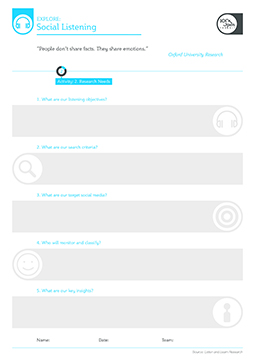Social Listening
“People don’t share facts. They share emotions”.Oxford University Research


Social media allow us to have conversations in new ways with many more people. They are powerful tools for gathering new insights in real time. These insights, in turn, will act as springboards for innovation.

This tool is to create a plan for researching social media to find out what people are saying about our brand, product or category. The tool helps us to decide who to listen to, where to find them and what to listen out for.
Our objectives will serve as the framework for analysing large volumes of content. What are we seeking specifically? Are we interested in comments about a new category, our brand, or problems with our product? Are we going to use the results to provide insights or stimulate discussion? What time frame are we interested in? A snapshot, a month or a year?
We need to decide on the focus of our search. It is often a good first step to look for category or conceptual conversations rather than just mentions of our brand. After this we can narrow down to specific search terms (e.g. in Twitter #hairgel rather than #hair). Having established the basic terms we can then look on line and build a library of related search terms (e.g. #badhairday, #volume or even #mullet).
Social media listening is time-consuming so we need to be selective. Facebook works well for certain categories. Twitter is difficult to interpret but great for real-time reactions. Instagram and Pinterest are great for visual insights and emotions. Once we have chosen our social media we then systematically search for content and make contact with and follow influential and relevant people.
It is best to classify interesting content in real time and either create different themes as we go or use our pre-prepared listening objectives. This will save much time in the analysis phase. There are automated services that will harvest data but 100%Open finds that this is best done by humans because what people mean in social media is highly context-dependent. For instance in deciding whether a particular post is funny, ironic or angry.
Next we review our listening objectives and analyse the content that we have classified. Social media analysis will rarely be as statistically rigorous as market research. It will however be full of genuine insights.
Source: Listen and Learn Research
You must be logged in to download this tool
You must be logged in to download this worked example
2014 - 100%OPEN LTD